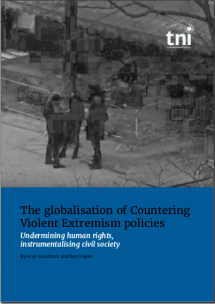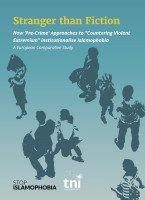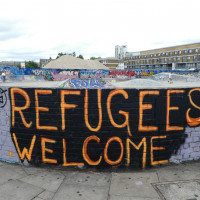The Globalisation of Countering Violent Extremism Policies Undermining human rights, instrumentalising civil society
The globalisation of Countering Violent Extremism (CVE) policies is the most significant development in counterterrorism policy in the last decade. What began as a rhetorical commitment from a handful of agencies has developed into a plethora of policies, deployed from Finland to the Philippines. This report includes a foreword by UN Special Rapporteur Professor Fionnuala Ní Aoláin.

Descargas
-
The Globalisation of Countering Violent Extremism Policies (PDF, 1.29 MB)Tiempo medio de lectura: 90 minutes minutos*
-
Resumen ejecutivo en catalán: La globalització de les polítiques de lluita contra l'extremisme violent (PDF, 245.65 KB)Tiempo medio de lectura: 20 min minutos*
-
Resumen ejecutivo - La globalización de las políticas de lucha contra el extremismo violento (PDF, 240.43 KB)Tiempo medio de lectura: 20 min minutos*
Autores
TNI’s timely new report — with a foreword by Professor Fionnuala Ní Aoláin, United Nations Special Rapporteur for the Protection and Promotion of Human Rights While Countering Terrorism — provides a critical account of the emergence of CVE policies and analyses their subsequent institutionalisation within three international bodies: the European Union, the United Nations, and the Global Counterterrorism Forum.
Today, the terms ‘radicalisation’, ‘extremism’ and ‘violent extremism’ are bandied about with such frequency and abandon that they have become synonymous with terrorism itself, despite their quite different meanings, and the lack of clarity as to how these concepts relate to one another.
Under the CVE banner, policy-makers at national and international levels have carried out engagement and outreach; capacity building and development aid; education and training; messaging and public relations campaigns; surveillance partnerships between policing and non-policing agencies; and targeted ideological interventions on individuals. CVE policies have significantly widened the range of methods used by governments for countering terrorism and shifted their target from terrorist organisation to religious ideology and identity.
Through the development of CVE, the war on terror has given itself a new vocabulary and a wider set of partnering agencies, from educators to artists.
What unites these policies is that they aim to reduce violent extremism by using methods beyond the use of military force and the coercion available under criminal law; they usually also aim to prevent the emergence of violent extremism before it has fully emerged in a region, community, or an individual, by addressing the underlying factors that give rise to it. Supporters of CVE policies see them as complementing more conventional, reactive counter-terrorism methods, offering the possibility of a long-term and holistic solution to terrorism. The forms these policies take vary from one context to another but the core ideas and principles are highly consistent – even as their implementation may be inconsistent - and have proven amenable to globalisation.
In this report we provide a critical account of the emergence of CVE policies and analyze their subsequent institutionalisation within three international bodies: the European Union, the United Nations, and the Global Counterterrorism Forum. While these frameworks were shaped primarily by western states, their international diffusion raises the prospect, as Steven Hawkins, Executive Director of Amnesty International USA put it, of repressive governments “taking advantage of ‘CVE-mania’” and “using international funding to violate human rights in the absence of appropriate safe-guards”.
It is important to stress, however, that these violations and abuses are every bit as present in Western states themselves. As such the problem as we see it is not simply one of democratic states exporting coercive policies to less democratic ones, but rather one of supranational organisations – including those with human rights mandates at their core – legitimising these problematic approaches by adopting them uncritically.
We are also concerned that the CVE framework has broken free of its national bounds just as those states in which the policies originated are coming to terms with the return of another kind of violent extremism. With the far right in or close to power in key liberal democratic states, the professed liberalism that sought to shape globalisation in its own image is itself under great strain, and struggling to contend with the political ascendancy of right-wing populism and authoritarianism in many parts of the world.
In Western democracies and beyond, this has led to demands for public policies that combat not just the (withering) appeal of ISIS, but which aim to counter violent extremists of every stripe. The subsequent ascendancy of violent extremists and white supremacists in the USA and Europe has created something of a crisis of legitimacy for CVE policies, which are for obvious reasons unattractive to the Far Right when they target anything other than ‘Muslim extremism’. These political dynamics have fractured the international consensus on combatting violent extremism that emerged after ISIS declared it had established a ‘Caliphate’ in 2014, a consensus built largely on the back of the second Obama administration’s enthusiasm and support for CVE.
The Trump administration’s withdrawal of support for ostensibly ‘holistic’ CVE policies – both domestic and international – coupled with abject political inertia when it comes to the violent extremism perpetrated or promoted by other populist or authoritarian leaders thus offers a much-needed opportunity for critical reflection on the paradigm as a whole. With the UN now calling for all of its member states to devise and implement national Action Plans, there is an urgent need for policymakers to reflect on whether CVE policies and practices that are anchored in a failed ‘war on terror’, which by any objective measure has only increased politically-motivated violence and extremism, are fit for purpose.
This report begins by examining the origins and proliferation of CVE policies and the problems that have accompanied and continue to surround their development and implementation. We then examine CVE policy and practice across the three aforementioned international bodies. The final sections contain conclusions and recommendations stemming from our research, including a framework we have developed to analyze the legitimacy of national CVE policies through their impact on fundamental rights and democratic and pluralist aspirations.
Finally, we would like to note from the outset that for all the ‘CVE mania’, it is surprising how little qualifies as the ‘evidence-led policy’ we hear so much about in other fields. Not only should we be asking for evidence that CVE policies are effective in terms of countering the terrorism, ‘radicalisation’ and extremism they purport to address, we should also be ensuring that in the absence of such evidence, policies do not risk exacerbating the divisions and grievances on which extremism feeds.





